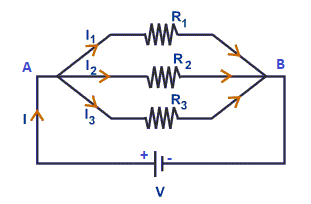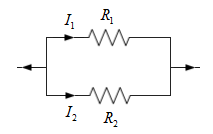Combination of Resistances in Parallel
Resistance in a conductor can be defined as the opposition offered to the flow of electrons. Resistance can be joined to each other in two ways:
Parallel Combination: If the resistances are connected between the same two points such that the potential drop across each resistance is same, then the resistances are said to be in parallel as shown in the below figure.

In this case, if V is the potential difference between the point A and B, then:
V = i₁ R₁; V = i₂ R₂; V = i₃ R₃
i₁ = V/ R₁; i₂ = V/ R₂; i₃ = V/ R₃
Therefore, the total current flowing through the battery is:
i = i₁ + i₂ + i₃ = V/ R₁ + V/ R₂ + V/ R₃
i = V (1/ R₁ + 1/ R₂ + 1/ R₃)

Also by Ohm’s Law, i = V/R, where R is the equivalent resistance between A and B. So we get:
1/ R = (1/ R₁ + 1/ R₂ + 1/ R₃).
